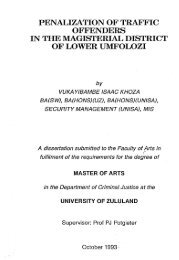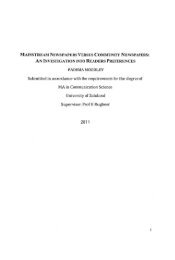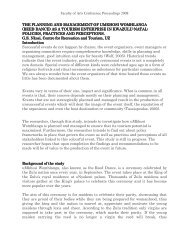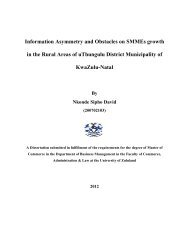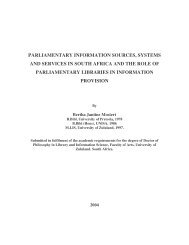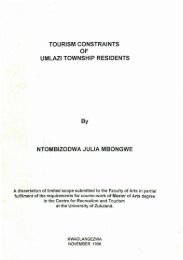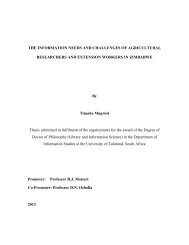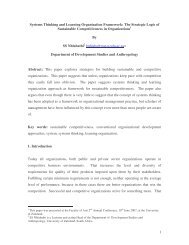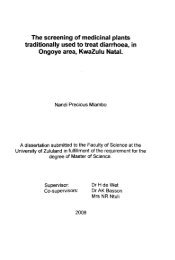ACOM342 Assessment Guide.pdf
ACOM342 Assessment Guide.pdf
ACOM342 Assessment Guide.pdf
- No tags were found...
You also want an ePaper? Increase the reach of your titles
YUMPU automatically turns print PDFs into web optimized ePapers that Google loves.
Course Outline1. MEDIA CONTENT1.1 Media Content Analysis-an overviewWhat is the message?2. MASS MEDIA AND VIOLENCE IN SOCIETY: SEX AND VIOLENCE IN THE MEDIA2.1 Theories determining the impact of media on the society3. TELEVISIONFormats- Magazine shows – Top Billing, Seskhona, Mzansi Insider, Top Shayela- Talks shows – Motswako, Noeleen 3Talk, The Talk, Redi on Mzansi Magic- Reality Entertainment – Idols, Survivor, Dance Your Butt Off, X-Factor, Wipeout, The Apprentice,- Factual / Documentaries (reality) – Khumbulekhaya, Relate, The first 48, Fire in Babylon,- Variety -- Drama -- Movies -- Current Affairs -4. RADIO Research Genres – documentaries, reality, talk, variety, docu-reality, drama, sitcom Storytelling Writing – across mediums, genres and formats Directing – formats, genres, studio v/s location The Look & Feel – graphics, wardrobe, make-up, set dressing & design, art direction – overall footage lookPRODUCTION Pre-production – production planning, design and coordinating, Production – scheduling, wardrobe, budgeting, reporting, invoicing, accounting and managing staff Post-Production – packaging, feedback and closing a productionTECHNICAL Production requirements – as prescribed by the client brief Sound Lighting – grading and style Camera – technical prescriptions, types and shooting style Editing – styles, software and equipment
Packaging – video and tape formatsBUSINESS Understanding the Media business Strategizing and crafting a proposal Responding to RFP (Request for Proposals) Client briefs Sponsorships & funding RecruitmentTHE BASICS Understanding the Industry (Media – Television, advertising, film, video, events, Public Relations, radio, web &desktop publishing) Understanding the anatomy of a productionCREATIVE Platforms / Mediums – Television, radio, print, film, video, PR, web & desktop publishing Research Genres – documentaries, reality, talk, variety, docu-reality, drama, sitcom Storytelling Writing – across mediums, genres and formats Directing – formats, genres, studio v/s location The Look & Feel – graphics, wardrobe, make-up, set dressing & design, art direction – overall footage lookPRODUCTION Pre-production – production planning, design and coordinating, Production – scheduling, wardrobe, budgeting, reporting, invoicing, accounting and managing staff Post-Production – packaging, feedback and closing a productionTECHNICAL Production requirements – as prescribed by the client brief Sound Lighting – grading and style Camera – technical prescriptions, types and shooting style Editing – styles, software and equipment Packaging – video and tape formatsBUSINESS Understanding the Media business Strategizing and crafting a proposal Responding to RFP (Request for Proposals)
Client briefs Sponsorships & funding Recruitment5. MEDIA AND POWERMarketplace of ideas and the public sphere6. STEREOTYPES, GENDER AND MEDIA STUDIESThe media’s portrayal of gays and lesbians7. MEDIA AND THE PRODUCTION OF MEANING: SEMIOTICSThe History of Semiotics8. FEMINIST MEDIA THEORY9. THE PRODUCTION OF NEWS“The module is based on more of research than just lecturing. Be geared up foradventurous exploration on theories that have to be studied in this module”.
Learning outcomes <strong>Assessment</strong> criteria <strong>Assessment</strong>methodsTime Frame4. MEDIA CONTENTMedia Content Analysisanoverviewo What is themessage?2 weeks5. MASS MEDIA ANDVIOLENCE IN SOCIETY:SEX AND VIOLENCE IN THEMEDIA5.1 Theoriesdetermining theimpact of media onthe societyWeek 36. TELEVISION Week 4 and 57. RADIO Week 6 and 710. MEDIA AND POWERMarketplace of ideas andthe public sphereWeek 7 and 811. STEREOTYPES, GENDERAND MEDIA STUDIESWeek 9The media’s portrayal ofgays and lesbians12. MEDIA AND THEPRODUCTION OFMEANING: SEMIOTICSWeek 10The History of Semiotics
13. FEMINIST MEDIA THEORY Week 1114. THE PRODUCTION OFNEWSWeek 12Course Rules and regulations:Welcome to this course and please take note of the following regulations:There are many ingredients that may lead you to fail! You will fail if you do not: Attend lectures Submit your activities/assignments on due dates Write your students number correctly on your answer book Follow instructions given to you by the lecturerPlease, learn to write legibly, neatly and avoid silly mistakes (grammatical errors) when writing. Youshould take responsibility of your own progress.In addition: Any form of work that bears plagiarism will not be marked! The course has been designed in such a way that there are to be practicals which will contribute to yourtotal mark at the end of the semester. These practicals will be dealt with in soloist set-up (individually) or ingroups! There will impromptu tests and assessments in class. This means, they will be conducted at randomwithout notifying the students. We do not study to pass but to equip ourselves for future purposes! You are, therefore, advised to open email accounts as this will help with easier and smooth interactionbetween the students and the lecturer.
Virtual classroom is active for user-friendly interaction. Down-load some notes and activities from thevirtual classroom: www.comsci.uzulu.ac.za/ASSESSMENTS You will write 10 assessments (multiple assignments/research based questions andpractical one) and ONE formal examination! Dates of assignments and assessments are provided in advance so that you have adequate study andpreparation time. If you miss an assignment deadline, your assignment will not be accepted and you will begiven a ZERO. Speak to your lecturer before the assignment is due and not on the due date. Assignments must be typed. Font size is 12, Arial/Times New Roman. Use 1, 5 spacing, justify your assignments.-------------------------------------------------------------------------------------------------------------------------CautionsApply the 13 th Commandment: “Thou shalt make a backup” (of your essay). Late submission because a discbecame corrupted or lost is not a valid excuse.Plagiarism is a disciplinary and a criminal offence! Plagiarism is the stealing of other people’s ideas,sentences and some in instances their specific use of particular words and phrases, without adequate citation.Where an essay relies overmuch on a single source, this can under certain conditions also transgress thelegality of laws on copyright.Proof-read your work thoroughly before handing in your assignment.



